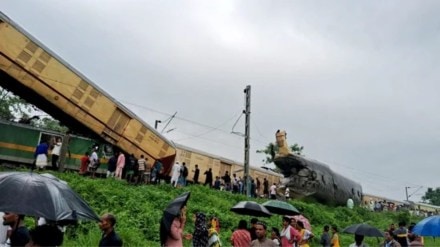Preliminary investigations into the Kanchanjunga Express accident suggest that the goods train breached speed limits mandated due to a “faulty” automatic signaling system on the route. The Railway Board reported on Monday (June 17) that the goods train collided with the stationary passenger train while exceeding speed limits, resulting in the tragic incident.
The accident, which occurred between Ranipatra Railway Station (RNI) and Chattar Hat Junction (CAT) in Darjeeling district, claimed the lives of seven passengers and two railway personnel, while 41 others sustained injuries.
The board clarified that despite the goods train driver being authorised to pass all red signals between RNI and CAT due to a malfunctioning automatic signalling system, the train exceeded the permissible speed limit for such conditions.
Goods train collided with Kanchanjunga Express due over speeding
Responding to reports, the board stated that the driver, who tragically lost his life in the accident, had been issued a written authority known as TA 912 by the Ranipatra station master, allowing passage through red signals. However, due to over-speeding, the goods train collided with the Kanchanjunga Express between RNI and CAT.
It may be noted that the Railway Board did not disclose the speed at which the goods train was traveling on that section. The driver of the Kanchanjunga Express followed the protocol for a malfunctioning automatic signalling system, stopping at each red signal for one minute and then proceeding at 10 kmph. The board stated that the goods train’s driver “ignored” these procedures and collided with the stationary passenger train from behind.
What is TA 912 letter which was issued to goods train’s driver?
Another railway official explained that in case of automatic signalling system failure, the station master issues a written authority known as TA 912. This authorization allows the driver to proceed past all red signals in the affected section due to the system’s defect.
“The TA 912 was issued to the (goods train) driver and, according to norms, when encountering an automatic signal at “ON” aspect (red signal) and after waiting for the prescribed time, the driver should have proceeded with great caution at a speed not exceeding 15 kmph where visibility is good, and not exceeding 10 kmph where visibility is not good until the next stop signal,” the railway board official said.
“He has to stop the train for one minute during the day time and two minutes at night at a red signal, and then start moving following the restricted speed norms,” the official added.
The authorization letter, TA 912, stated, “Automatic signalling has failed, and you are hereby permitted to pass all automatic signals between RNI and CAT.” It specifically notes that there are nine signals along this stretch and grants the goods train driver authority to disregard whether they display red, caution (yellow), or double caution (double yellow).
Faulty automatic signalling system lead to collision
Earlier, it was brought to light that the automatic signalling system between RNI and CAT had been malfunctioning since 5:50 am on Monday. “Train No. 13174 (Sealdah-Kanchanjunga Express) departed Rangapani station at 8.27 am and stopped between RNI and CAT. The reason for the stopping of the train is unknown” the source told PTI.
“The station master of Ranipatra had issued TA 912 to Train No 1374 (Sealdah-Kanchanjunga Express),” the source said.
He added that “around the same time, a goods train, GFCJ, departed Rangapani at 8.42 am and hit the Kanchanjunga Express from behind at 8.55 am, resulting in the derailment of the guard’s coach, two parcel coaches and a general seating coach (of the passenger train)”.
Commissioner of Railway Safety to probe accident
Railway Minister Ashwini Vaishnaw announced that the Commissioner of Railway Safety (CRS) has initiated an investigation into the incident where a goods train collided with the Kanchanjunga Express from behind near Rangapani in West Bengal on Monday morning. Vaishnaw emphasized that steps will be taken to prevent similar incidents in the future.
“The accident is under comprehensive investigation by the Commissioner of Railway Safety,” Vaishnaw informed reporters at the accident site in Rangapani, near New Jalpaiguri station in Siliguri. He also confirmed the conclusion of rescue operations.
